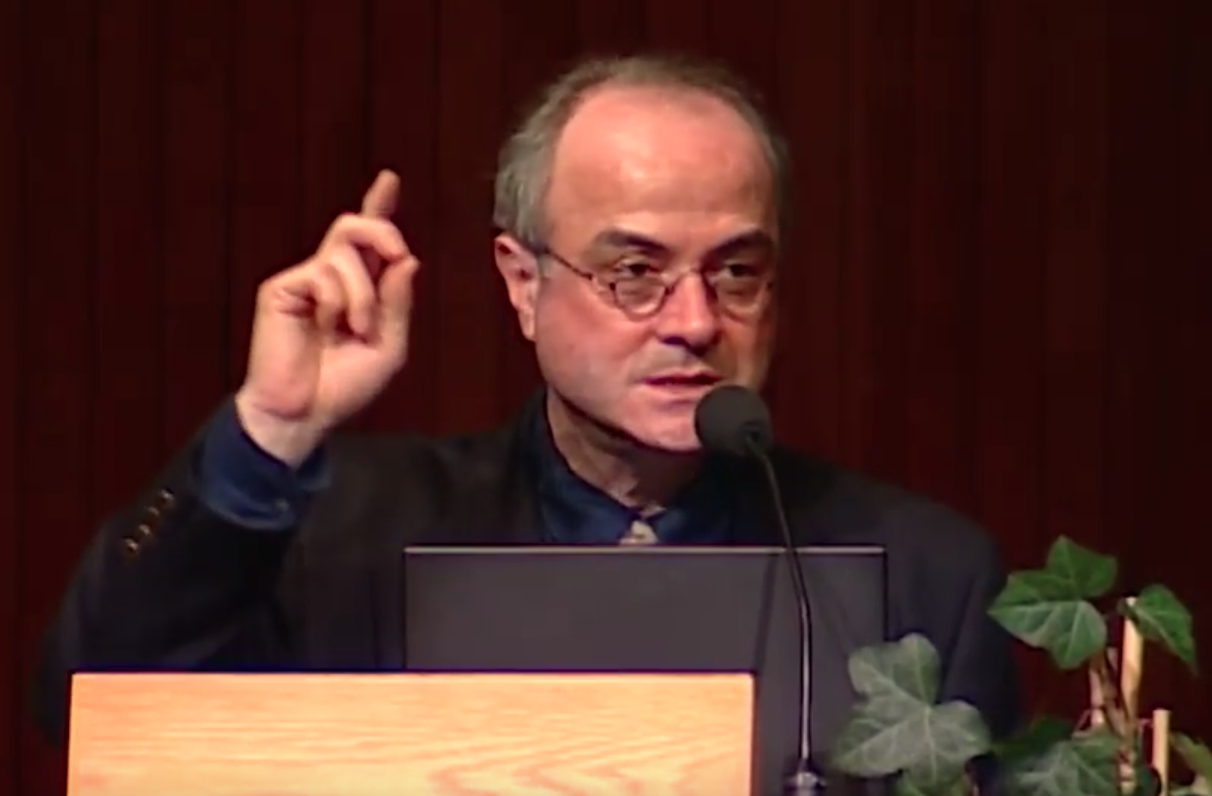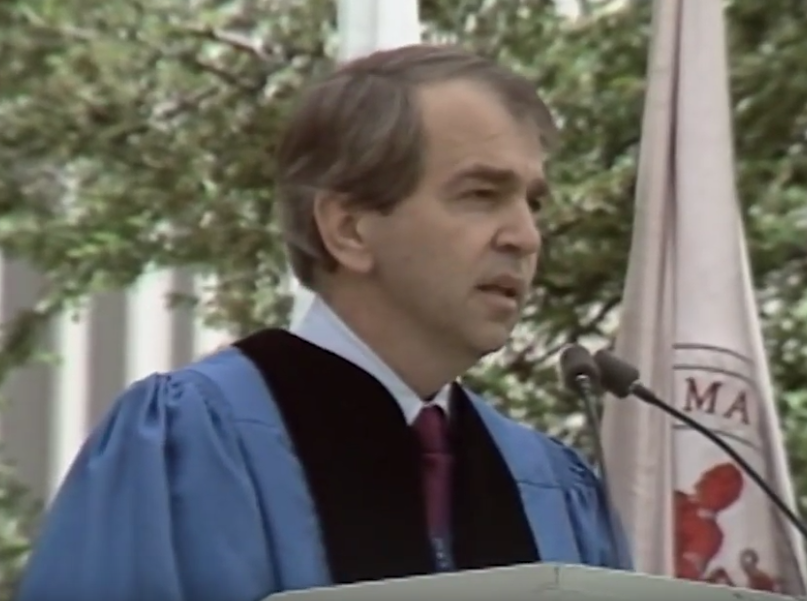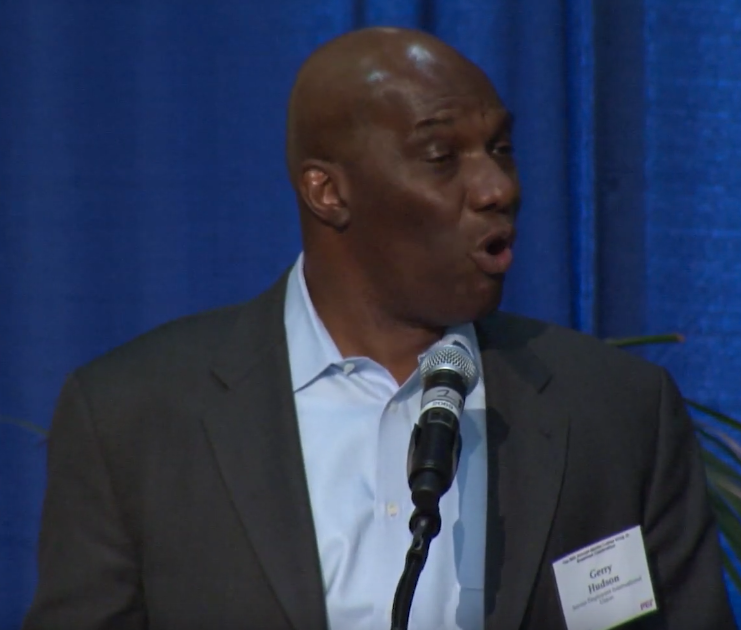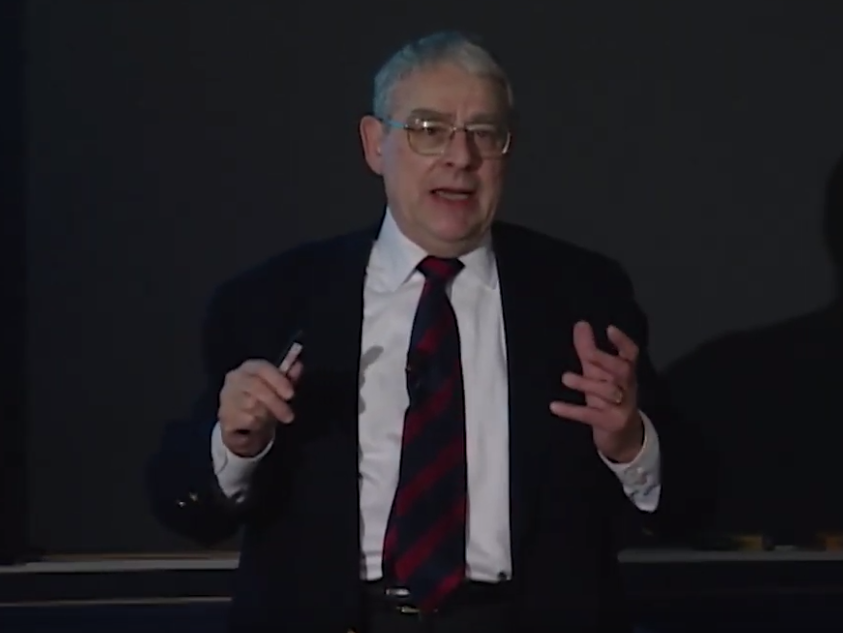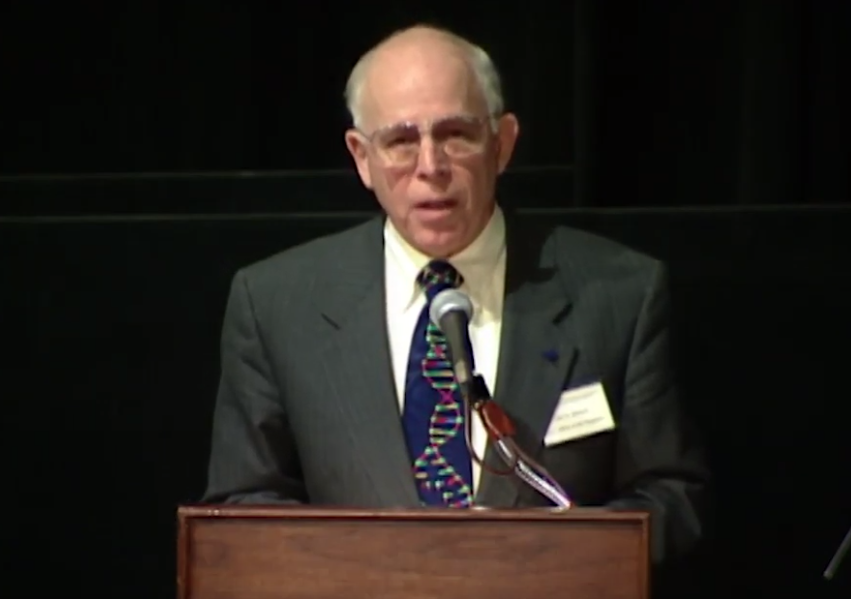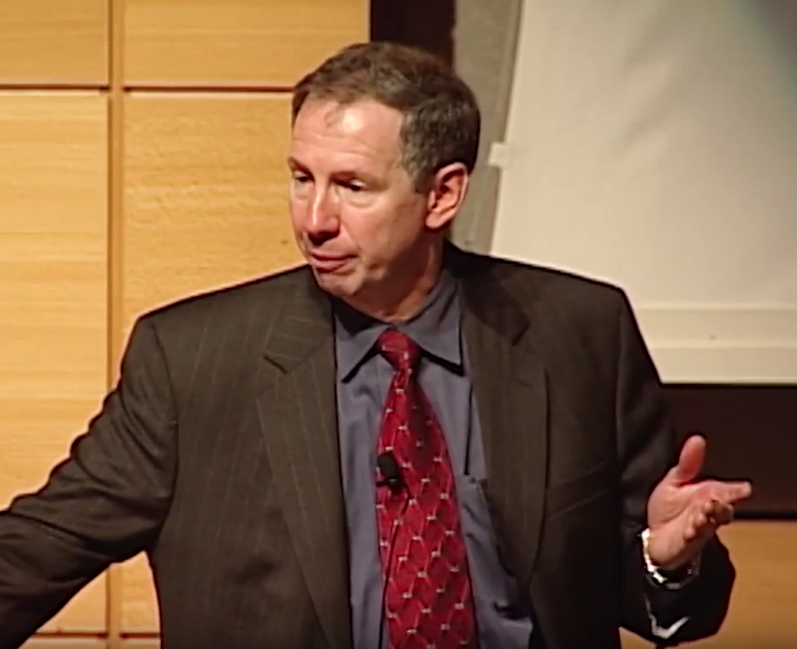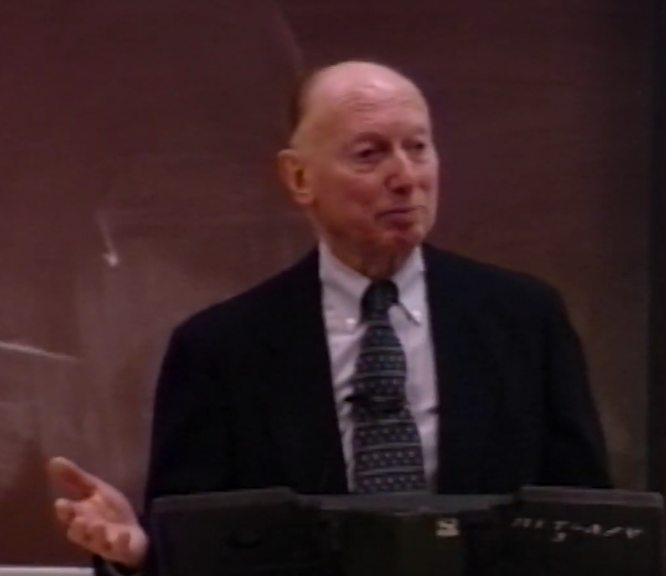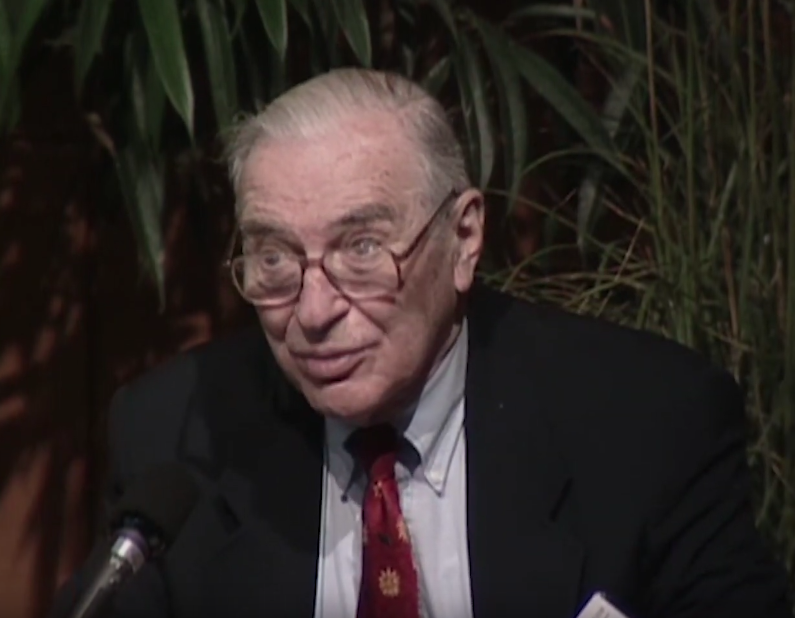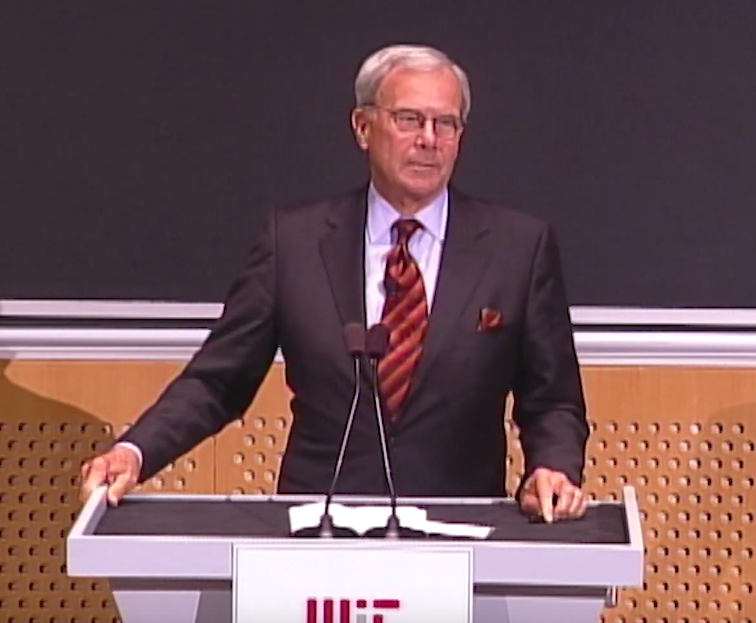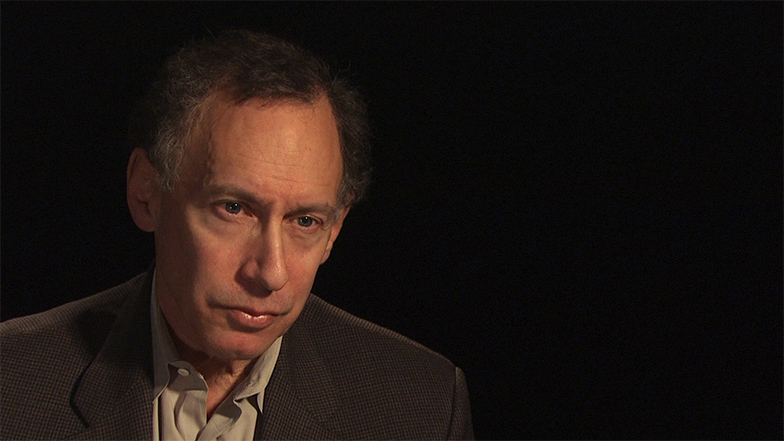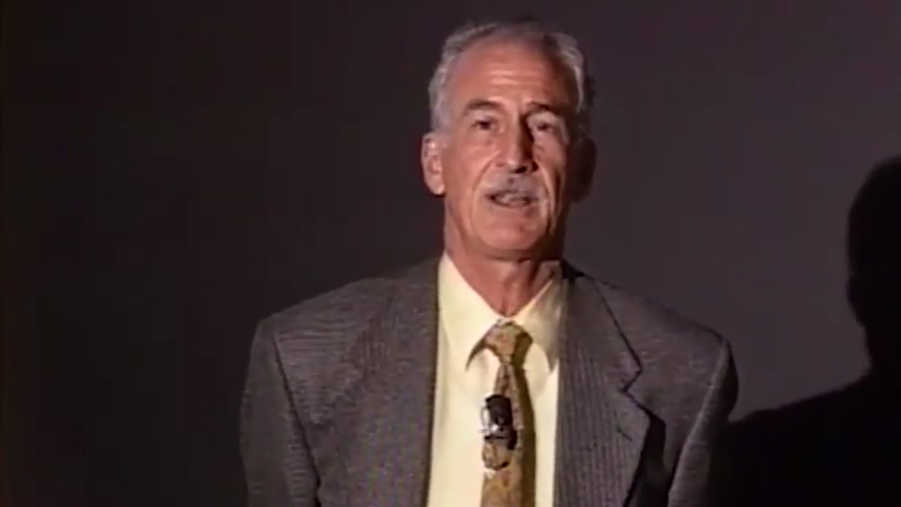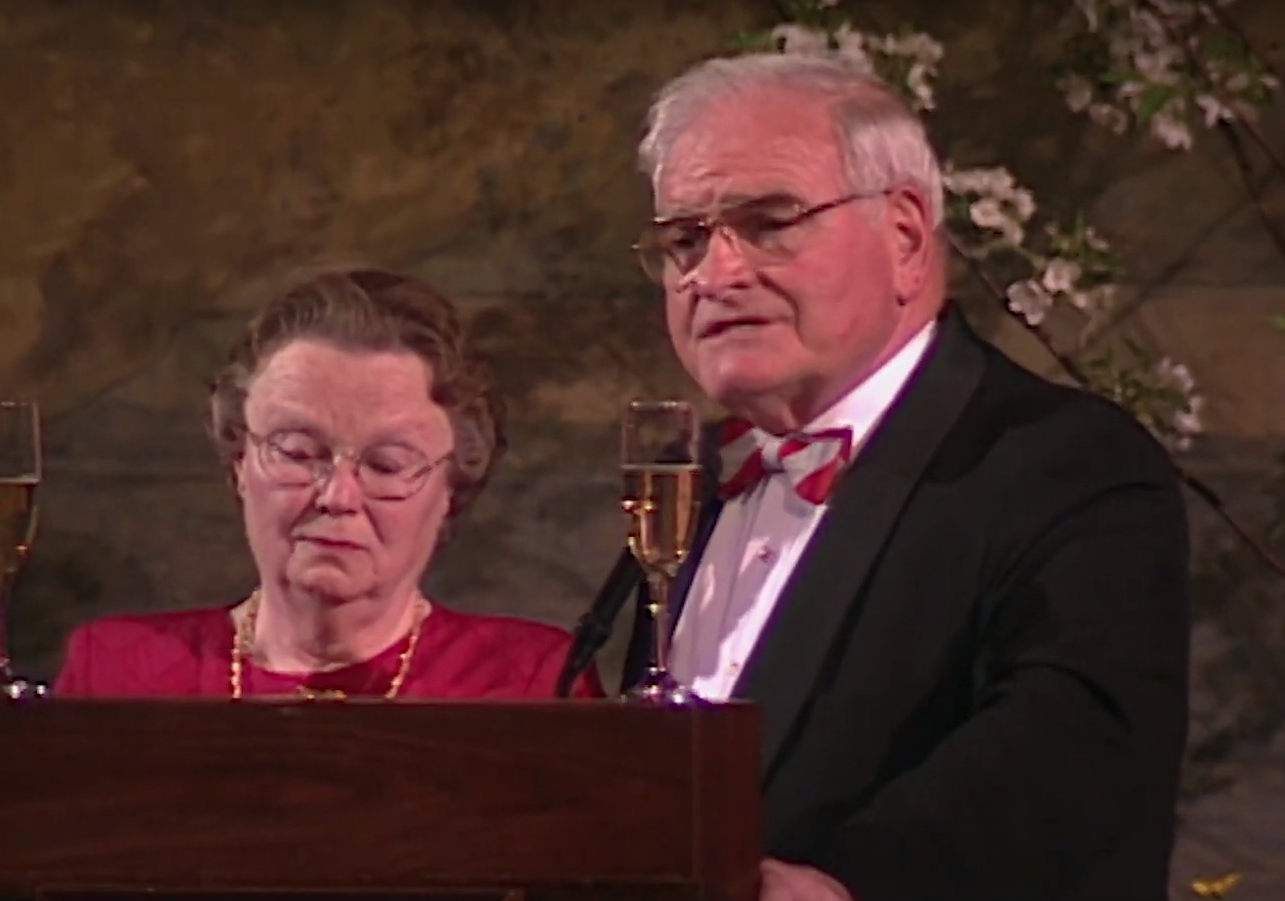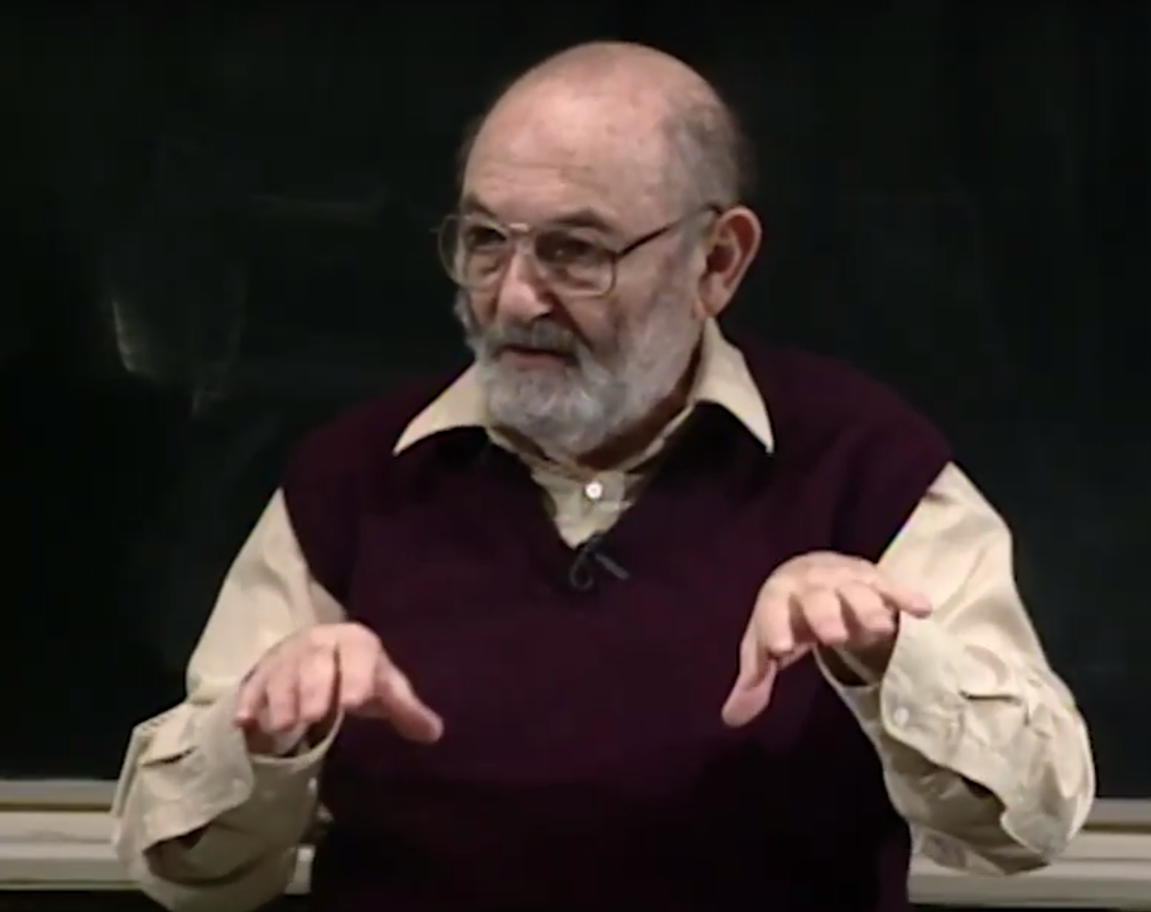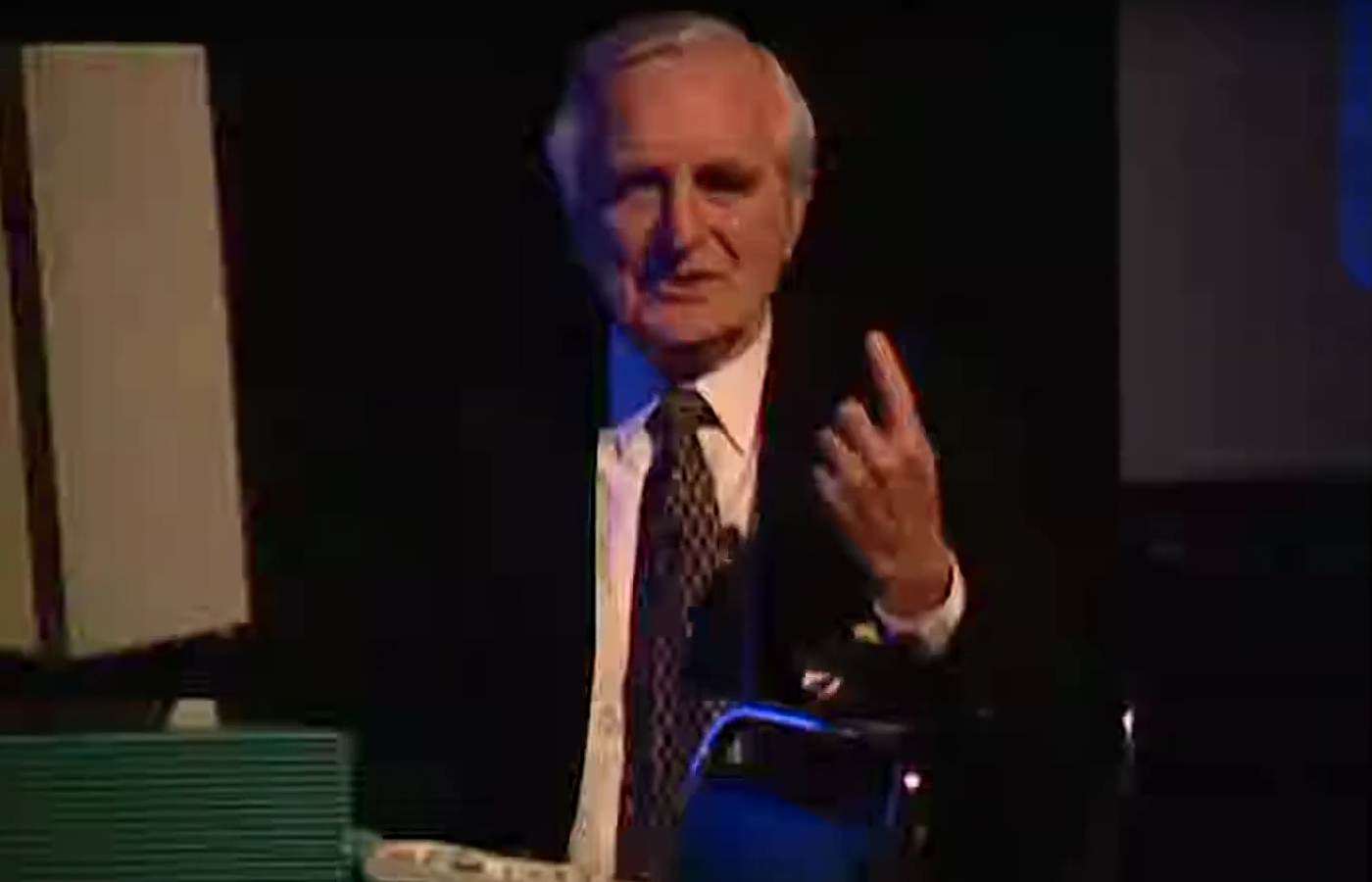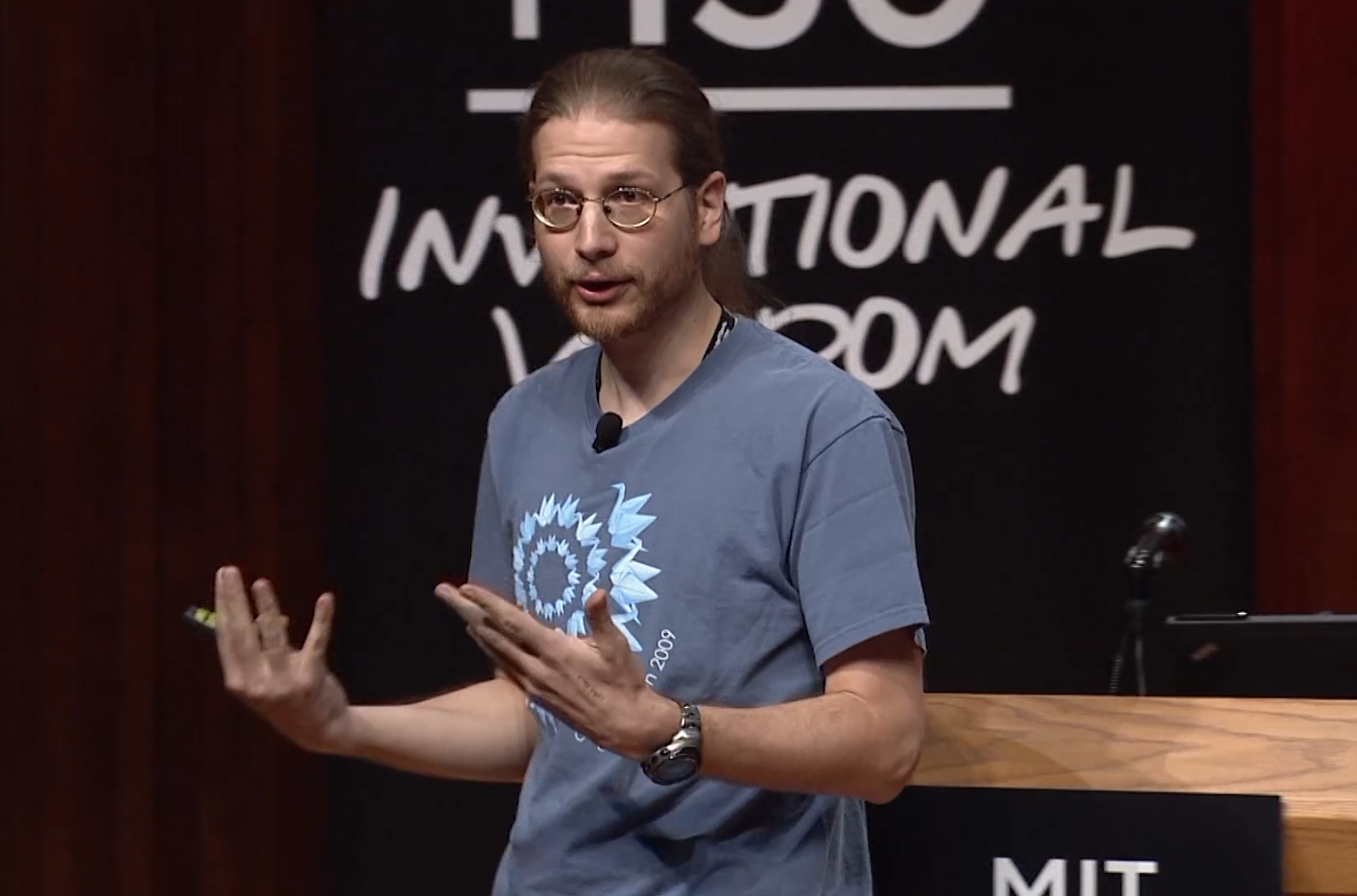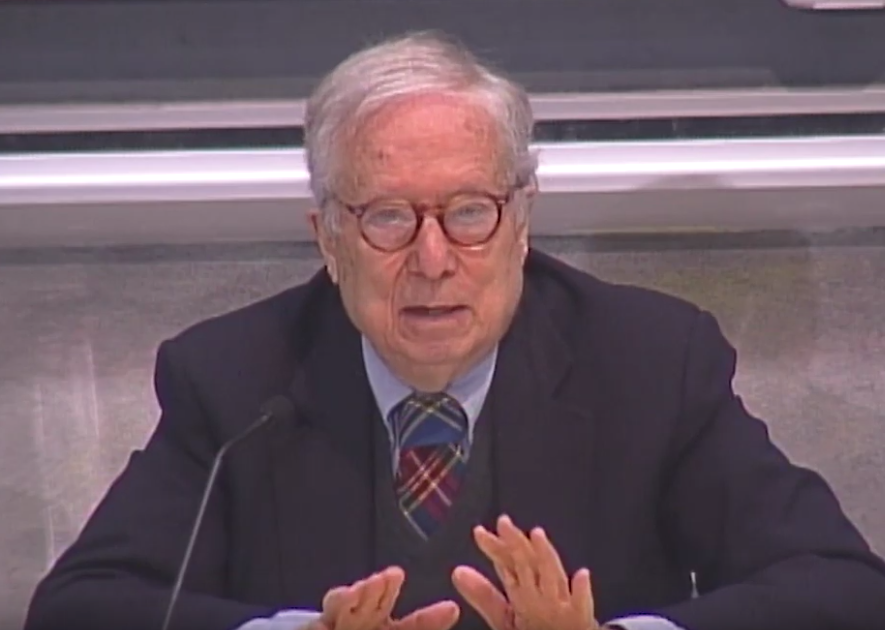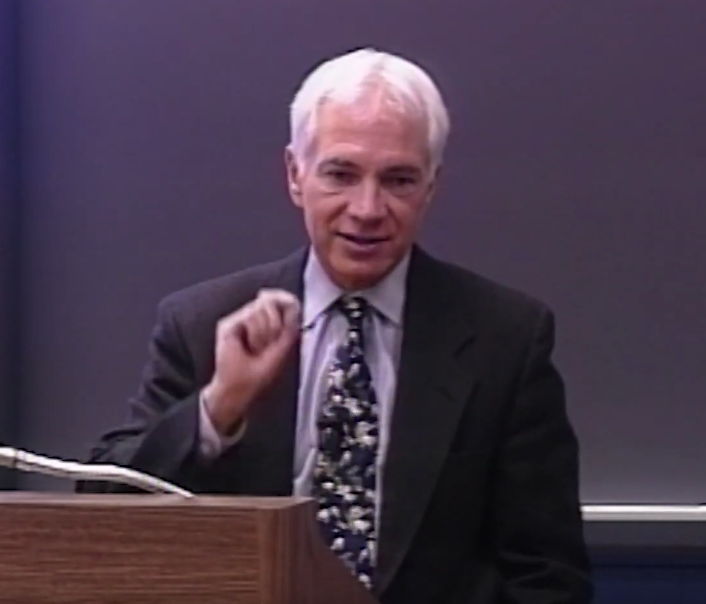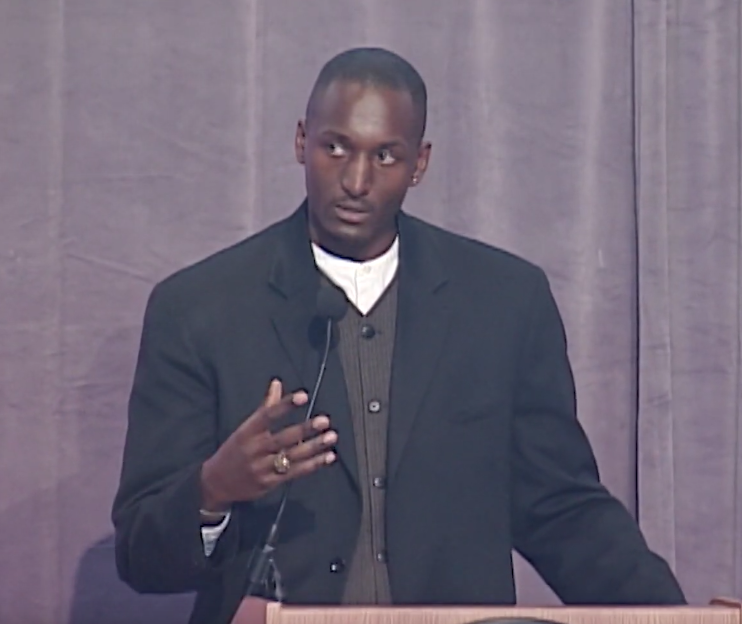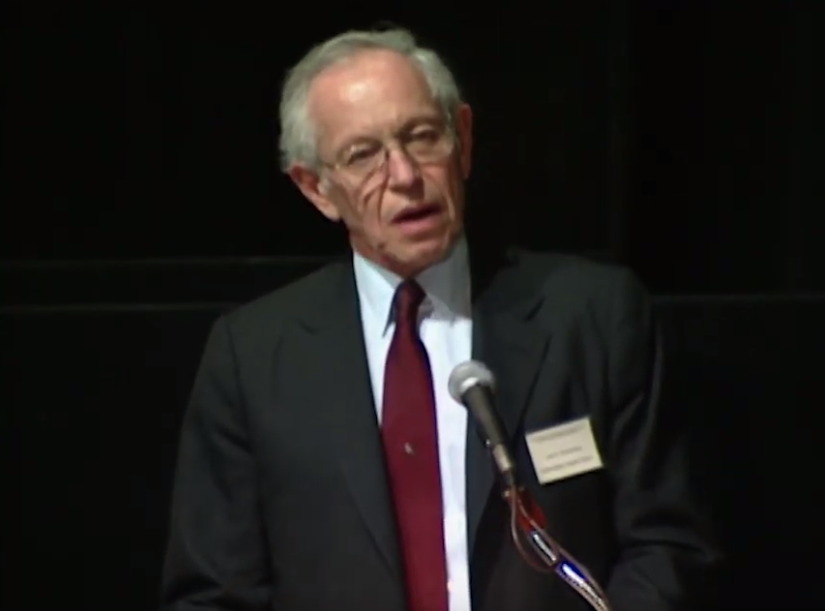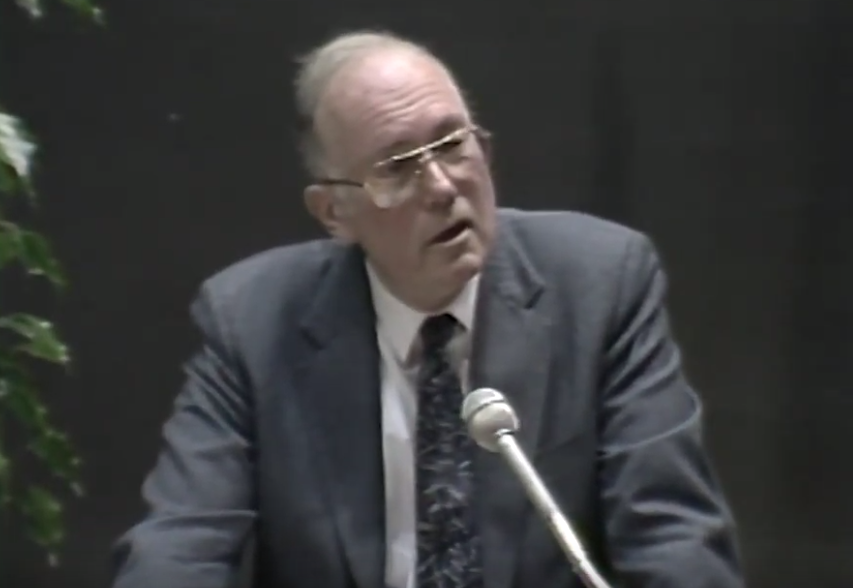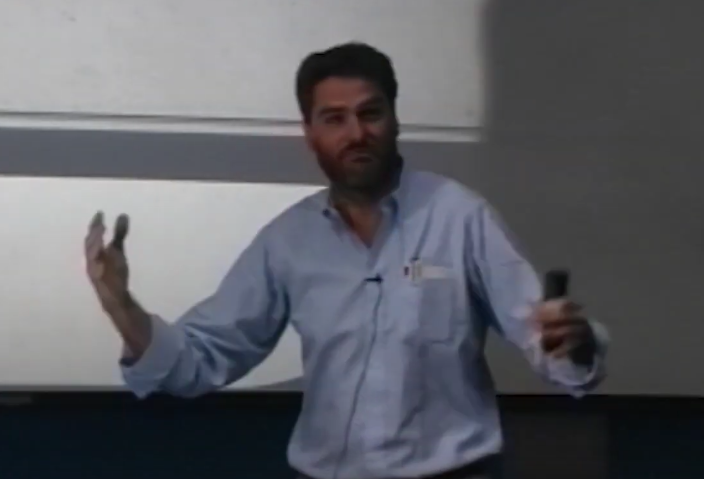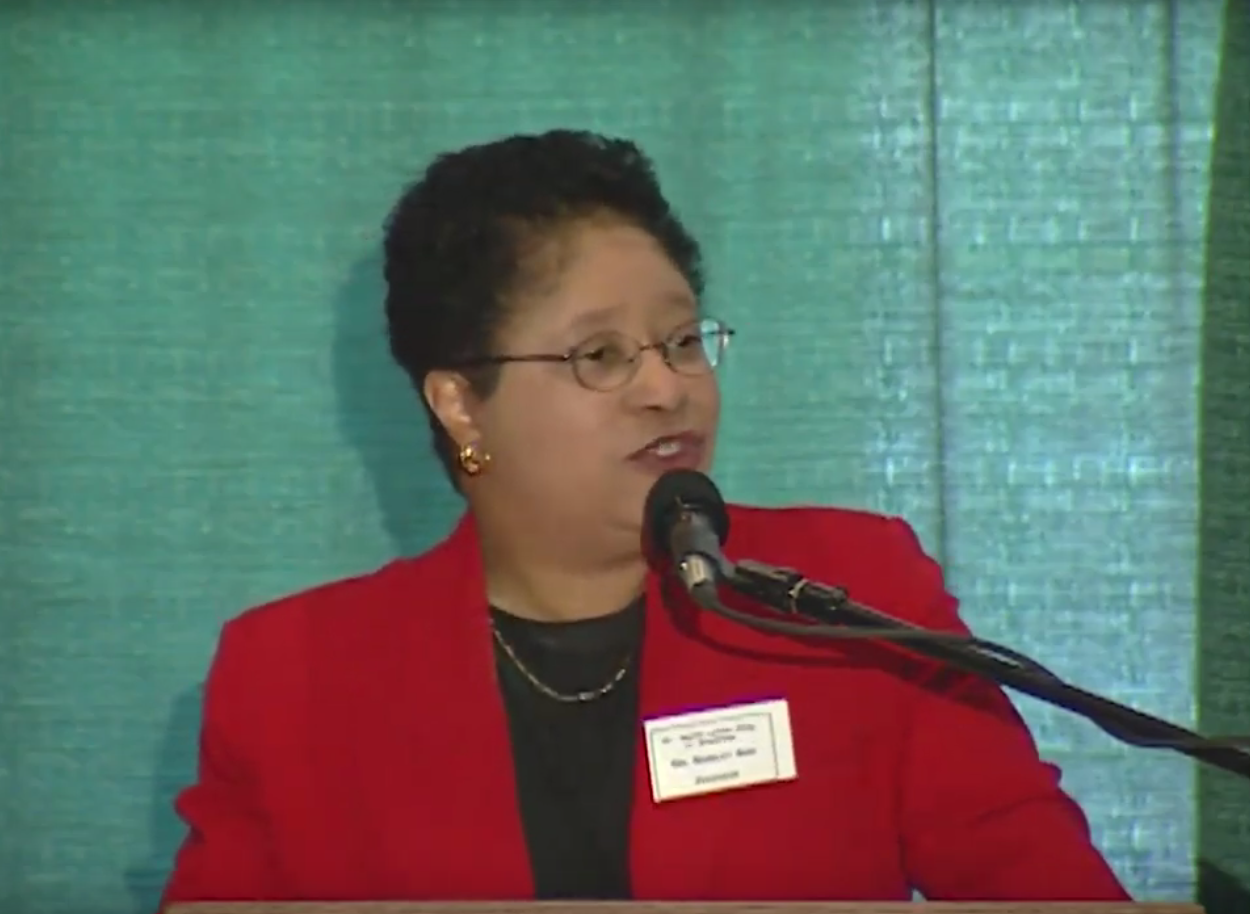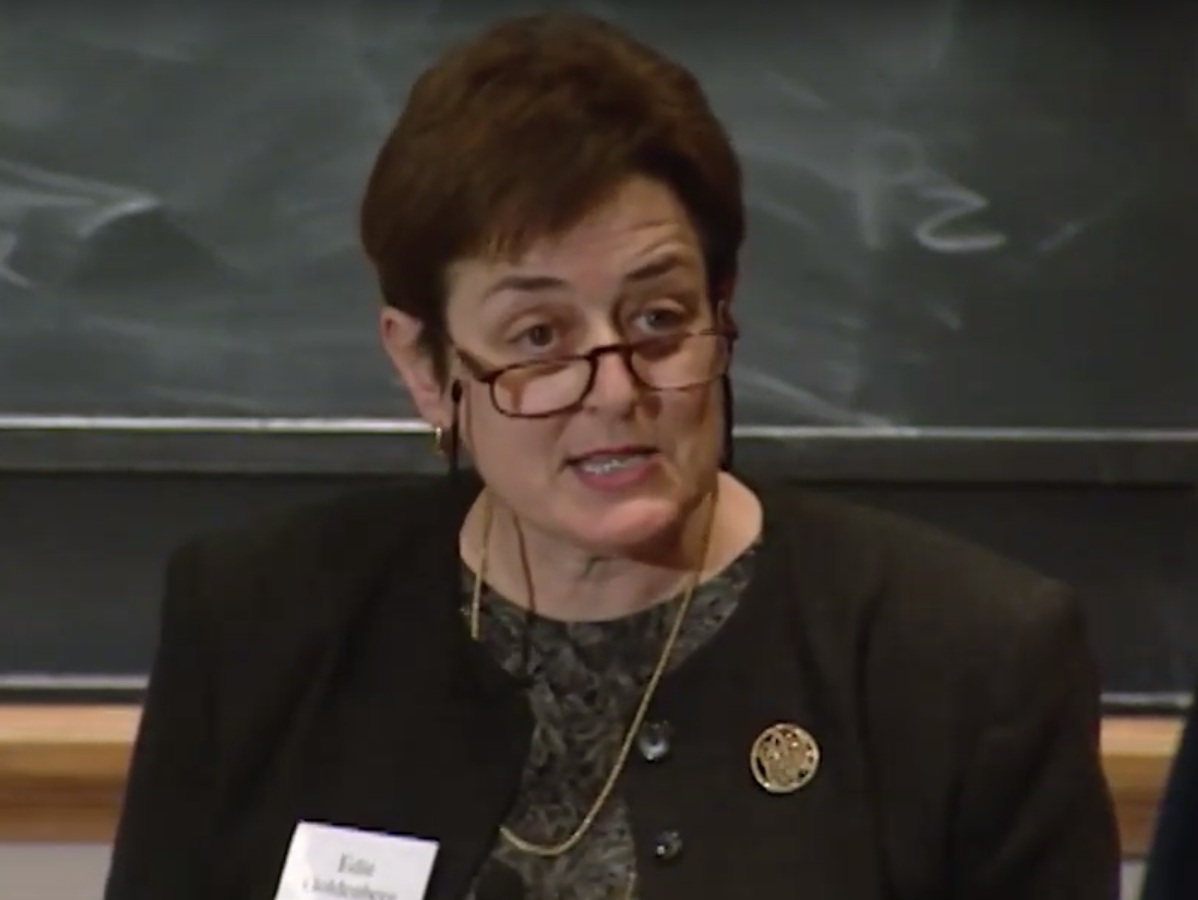EECS Special Lecture - Professor Millie Dresselhaus on Bismuth Nanowires: Structure and Properties
[MUSIC PLAYING]
In '72, Millie became the associate department head in EECS and before then and since then has had a very illustrious career in research and science. At one time, Millie, I guess about 10 years ago, was president of the American Physical Society. She's an institute professor and has appointments in both the department of physics and the department of electrical engineering.
She won the National Medal of Science back in 1990, probably the highest award that the country US can give to one of its scientists. She's the recipient of over 17 honorary degrees. Recently in 1999, she received an honorary degree from the Sorbonne in Paris. And it turned out that she's the first woman to have received an honorary degree in the sciences from the Sorbonne.
In this year, just last week, she received an honorary degree from the University of Leuven in Belgium and next week will be giving the [? Celsius ?] lectures at the University of Uppsala in Sweden. As I say, Millie has a very illustrious and long list of honors. And if I went through all of them, I'd take up half of her time. I think you really want to hear from Millie.
[APPLAUSE]
I'm very honored to be the first one. Again, I did the first in the EECS series about a year or a year and a half ago. And so it's auspicious beginning, as we all say.
My topic today is very different from last time. This time, I'm talking about bismuth nanowires. And I could give almost the same topic title as I gave last time, which was The Remarkable Structure of Properties of Carbon Nanotubes. That's the last one I did in the EECS Colloquium. But I was a little bit more modest because the bismuth nanowires are a lot newer and maybe we don't know exactly all the remarkable properties about them yet.
Well, I have a few collaborators, actually worldwide, and a lot of graduate students. And three of them have already gotten their PhDs related to this topic, so a good subject for training students. Now, in light of the invitation, I thought I would focus my remarks about nanostructures before I start talking about bismuth.
Those of you who listened to the president's State of the Union speech, he didn't have a lot to say about science, but he did have something to say about nanostructures. And so nanowires are a part of nanostructures. So I'd like to call your attention to the importance of this.
And in my first viewgraph, I'm trying to give you the scale of what a nanostructure is. And so here we have a plot, and we have a plot of different things on a scale. So you see that the x-axis here gives size. And there's a line here. That's at about 50, 70 nanometers, something like that.
And anything below that begins to show quantum effects. And with quantum effects, it's not that we're just making things smaller and smaller to get a higher packing ratio of whatever component it is like we're doing silicon technology. The first thought is to pack our devices smaller and smaller so you get a higher packing density. But when you do this, you also get new physics that comes in that allows you to do new things. And it's the second point of view that I'd like to stress in my talk today.
So you see here on this picture, there are a lot of different things-- GMR, Giant Magneto Resistance; quantum dots and lasers; nanotubes, carbon nanotubes, which I talked about in my last EECS Colloquium, et cetera. And bismuth nanowires span the scale moving into the nanostructure regime where quantum effects are important.
My second viewgraph of a general nature about nanostructures tells you in simple terms why nanostructures are important and interesting, why anybody cares about them, why President Clinton said that this is something that we should be thinking about and working on. Why is that? Well, when we have bulk semiconductors as we know and we love in the industry, what we basically have is this situation shown on top where the density of states-- that is the number of states per energy range-- is essentially continuous. That is, we have a crystal structure that's really quite large compared to the quantum regime limit.
On the other end of the scale here, quantum dot, labelled quantum dot, where we might have a single atom or molecule, we have discrete states. And somewhere in between, we have one-dimensional systems. Like here, we have the quantum wire. Or in this case, we have the quantum well, which is a two-dimensional system.
And you will see that the density of states-- that is the number of states per energy range-- is distinctly different. And the smaller the size or the smaller dimension that we're dealing with, the more the system becomes like a molecule with these discrete states. Now, when we are in the regime of the discrete states, we have new phenomenon. And that's the kind of thing that I'm going to emphasize in my discussion of the bismuth nanowires where we're interested in going to smaller and smaller sizes where the system shows quantum effects, that phenomenon that are not present in the bulk.
Now I'd like to tell you how I got into the bismuth nanowire business. And this was motivated by practical considerations. One of the nice things about being in an engineering department is we have a push and pull between the practical and the science-based studies. So my initial motivation for this came from a practical driver, and this is interest in making thermoelectrics that are better than present thermoelectrics.
Thermoelectrics have two applications. One is for cooling purposes, and the other is for energy conversion at high temperature. And here is a picture diagram of the thermoelectric figure of merit. For our present discussion, this isn't particularly important except to say that the state-of-the-art has a value of this quantity, figure of merit, ZT, dimensionless quantity, of 1. And it's been at this value since approximately 1960.
If thermoelectrics could have their figure of merit increased to a factor of 3, they could be competitive to a refrigerator, something that we know. And it would change the economics and interest in this kind of applications area enormously. However, nobody has figured out how to do this, and not for lack of effort but lack of ideas. We had an idea about how to change this a few years ago by going to low dimensions.
And you could see this picture is sort of a visionary picture. And it said if you could make a one-dimensional bismuth, or two-dimensional, for that matter, we could exceed the ZT of 1 with small sizes of either a quantum well of bismuth or a quantum wire of bismuth and in fact get values that are phenomenally bigger than even what you could do with a refrigerator. However, there's a long way to go from the actuality and this phantom dream.
The material, the actual material that might do this would be this bismuth that I mentioned, which has some astounding properties. Of all materials, it has a constant energy surface-- we call this a Fermi surface-- that is more anisotropic than any other material. Anisotropy in the Fermi surface is very, very desirable for thermoelectricity, as is multiple carrier pockets, which is another feature of bismuth.
Bismuth also has a very high mobility, which is another promising feature for thermoelectrics. And because it is a very heavy atom, it has a very low thermal conductivity. And for all of these reasons, this should be the ideal material to be used for thermoelectric.
However, the problem with bismuth and the reason why bismuth has never succeeded as a thermoelectric has to do with the following point, property. Bismuth is a semimetal with an equal number of electrons and holes so that the top of the valance span, shown here, is higher in energy than the bottom of the conduction band. So it's sort of a semiconductor with a negative bandgap.
So you always have both electrons and holes present. And for thermoelectricity, the contribution of the electrons essentially cancels that of the holes, and it is a very poor thermoelectric material for that reason. However, if you could figure out some way to make this material either totally n-type or totally p-type-- and for thermoelectric, you have to be able to do both-- then this could be very, very interesting.
So here is the idea. And this is an idea that we had simultaneously almost with the idea of doing low-dimensional thermoelectrics. What I have shown on this picture here is the subband structure or the first subband for electrons related to the band edge for the bulk and the first subband which is below the bandgap edge for the holes, as shown on your left-hand side.
So now, as the size of the quantum well or the quantum wire decreases, the difference in energy between the first subband and the band edge increases. So this subband edge will move up. And for the holes, this subband edge will move down. And eventually at some value of the size of your quantum well or your quantum wire, a semiconductor will be formed. And once you have a semiconductor, you could make that either n or p-type.
So that was the initial motivation of us studying bismuth. And we talked somebody into giving us some money to do this. So we started work on this project. But an idea was necessary because it isn't easy to make any low-dimensional structures with bismuth because bismuth diffuses into almost everything. So we had to devise some mechanism to have quantum-confined system.
And the idea came through a public service activity for Jackie Ying, who's a collaborator on this project. And she invited me to tell chemical engineers about carbon nanotubes. And while they were listening to me tell them about carbon nanotubes, I thought I should listen to them tell me about catalysis.
So I listened to a lecture and heard about molecular sieves and my cells that will self-orient. This is used in the oil recovery business. They have, of course, no interest in making low-dimensional semiconductors.
But in listening to them, I had the idea what they do is make self-organized holes in a template. So they make something that looks like this. And when I saw this, I said, viola, this is exactly what we need for low-dimensional thermoelectrics and many other scientific applications.
So we start out here with an aluminum film. And so that's like aluminum foil. It's a little bit maybe higher purity and we polish the surface, et cetera, anodize this electrochemically. And there's a competing mechanism that forms these holes. And depending on the acid that's used for the electrochemical treatment, the length of time, the voltage, current conditions, you can control the size of the pores, et cetera.
So these pores are made. And then we use another acid to take off the bottom and high pressure to fill the channels that are formed eventually with fluids-- in this case, bismuth, but you can put in magnetic fluids, something goes superconducting, many, many possibilities.
And for some applications, we would like to measure individual wires. So we dissolve this template. We have individual wires to make for probe measurements on individual wires. That's where Hank Smith's help has come in.
So Jackie Ying taught us how to make these templates and helped us with the filling of the templates. And we had a lot of help from Professor Smith with his kind introduction. But he's done more than that. He's helped us to make transport measurements.
Our earliest work was done. This is our first attempt. And you see here, first student. So these wires are a little bit on the large side, 65 nanometers, just at the junction of being called nanostructures.
And so looking down top-on, you could see these cylinders. They're not so perfect, but the length-to-diameter ratio is about 1,000-- 1,000 aspect. So they're long, skinny things.
And the density of wires here was approximately 10 to the 10th wires per square centimeters. We do more than that with the smaller wires. So there were a lot of wires that are made.
And I'd like to show Yumeng's more recent work with improved processing step. And this is a much smaller diameter wire. And they're more perfect than the large ones that the previous student made.
And now we're down to 18 nanometers, and these aren't so bad. We have ideas for improving them further. So the technology is challenging to us, but our electrical engineering students seem to be able to handle this and make progress with it.
When we take the templates, dissolve the templates, you see here the freestanding wires. They're very long and skinny. And with high-resolution TEM, you could see that they're fairly straight.
And these striations show grain boundary structures, not very many grain boundaries but some grain boundaries. And the size of these grain boundaries is about the diameter of the tubes. So this is something that we're very interested in.
Now, the nanowires would be of relatively little use were it not for this great property that they have, that the nanowires are single crystals with common axis along the wires. So a given wire will have a common axis, but all the wires in the array, the 10 to the 10th or so wires, will have the same common axis, most of them, a high percentage. And you could see this as the X-ray diffraction pattern with very sharp lines so it looks like a single crystal.
Now, what we found recently-- in our first work, we were making bigger sized wires. And all the wires had the orientation 101. And we thought that they'd all came out that way. But as the wire diameters got smaller, we have a new preferred orientation that goes from 40 down to about 20. And we haven't really done much characterization below that length, but we suspect that they're also single crystals.
So this is an important property. Why is it important? All the wires are the same so they have a common property. So we can characterize them.
And because of this, we're able to have very long mean free paths. We have a property that's called ballistic transport that I'll describe in a little bit that says that the electrons will move for very long distances before being scattered, for distances that are much longer than the wire diameters. So that's an important consideration.
Another thing that I should mention about this that makes this property quite remarkable is that the crystal structure-- that is, these diffraction peaks-- are exactly at the same places, same angles as they are in bulk bismuth. So we have basically bulk bismuth that's put in the wire. So almost everything that we know about bulk bismuth also applies to the nanowires. This was an unexpected, lovely property for these nanowires.
Now, other people have tried to make nanowires before of this sort, but this was the first successful attempt of making single-crystal nanowires, certainly of bismuth. Now, how do we know that they're all the same? Well, we have an X-ray diffraction pattern which gives you the diffraction pattern of many, many nanowires. And then we have an electron diffraction pattern for single, selected nanowires.
And so from this pattern, we can tell what the orientation happens to be. And that orientation is the same as for the X-ray diffraction. So we know that not only do we have single crystals, but they're all the same, close to all the same. Obviously there's some deviation. You never have perfection in a project like this.
The Raman spectra is also interesting. And I show, on top, the Raman spectra for bulk bismuth. And because it's such a heavy atom, the vibrational modes are at very low frequency.
And when we make the nanowires, you'll see that the same frequencies appear. So we have the same mode structure, but the relative intensities are different. And this is an area that we hope to be studying in the near future.
So to summarize about the remarkable structure of the nanowires-- so here's the structural properties. We have narrow distribution of wire diameters, less than 10%. They're quite uniform along the length-- again, much less than 10%. They're single crystals with a common axis along the wire but otherwise randomly oriented in the cross-sectional area with respect to each other, not with respect to each one but with respect to each other. And they have the same crystal structure as bulk bismuth.
The template material in which the bismuth nanowires sit is a wide-gap semiconductor, 3 and 1/2 electron volts. So we have quantum-confined electrons in the wires. They don't talk to each other. And thermal conductivity is very low, and a bunch of other interesting properties-- dielectric constants very high, a few other interesting properties.
Now I'm going to talk about the unusual properties. Up until now, we talked about the structure. Now I'm going to talk about the properties. So the first thing was the semimetal-semiconductor transition. And just to remind you what that is-- I hope I can find my little viewgraph that showed that. Here we go.
So this is the basic viewgraph. What we're looking at, we're looking for that diameter for the wire where this subband for the holes crosses the highest electron subband for the electrons and a band gap is formed. So that's the concept of what we're looking for.
And now I'd like to give a few examples of its observation. So we have optical properties, transport properties, and several other properties. So now to get a little bit more specific about the bismuth structure, I have to show you-- bismuth is a complicated material. And if it weren't complicated, most of the things I'm talking about would not happen.
So we have the L-point electron. So these are the L-point electrons. And there are multiple carrier pockets which will have the same energy in the bulk material. But once we make nanowires out of them, then we have a splitting in energy between them, and that complicates our thinking about the problem. But for this audience and the simple picture, we'll neglect that for the most part.
And here are the holes. And if we didn't have the rhombohedral crystal symmetry and this were cubic, the T-point holes and the T and L point would be all the same, and we wouldn't have a semimetal so that the special properties of bismuth that allow us to make a semiconductor out of it by going to low dimensions are bound up, are closely connected with the fact that bismuth is anisotropic.
OK, so this is an important consideration. I'll return to this at some point. And now, just, I'd like to mention about the semimetal-semiconductor transition. So here's our picture for the semimetal-semiconductor transition.
At large values of the wire diameter, then the separation that we're talking about here would be a band overlap of bismuth, which is about 40 millivolts. What's shown here, for the direction that the wires actually grow, we have the A-point pockets that are along this cross-section, which is the mirror plane of the reciprocal lattice zone, this carrier pocket is different from the B and C. The details of that are not terribly important for our present discussion.
In the limit that the wires are very large, then these two lines become equal to each other and we have a common value for this band overlap. As the wire dimension gets smaller, we get a splitting. And this shows the splitting that makes the A and B and C different. And the reason for that has to do with the relation of the symmetry of these carrier pockets and the growth direction which are not along a common high-symmetry axis.
The important point is that as the diameter gets smaller, eventually we get a crossover with this whole band level. This is the highest conduction subband for the holes. And at this point, we cross this A-point carrier pocket. And at this point, we cross the B and C carrier pocket. And at this point right here, 50 nanometers, we make the semimetal-semiconductor transition.
So that's what we're talking about. And what is the evidence that we have for observing this phenomenon?
[INAUDIBLE] where's the Fermi energy [INAUDIBLE]
Well, the Fermi energy will be somewhere between these two such that the number of electrons is equal to the number of holes, OK?
[INAUDIBLE]
Hm?
[INAUDIBLE]
It goes right through here if you have [INAUDIBLE]. So how would this be observed? Now, the most prosaic and simple observation is to do an optical absorption experiment.
So if you have a semiconductor, then you have a transparent situation, very low absorption. And if you have a semimetal, you'll have relatively high absorption, and that's what's shown here. So this is a very crude, simple-minded picture of what you might see. And so this is the first experiment we did. So that's like a flashlight-type experiment.
And we're trying now to do this much more quantitatively. And that's the thesis of Marcie Black. And she's making good progress with it. So hopefully, soon we'll hear more details.
The transport properties are quite interesting. So here is bulk bismuth. So this is resistance normalized to the room temperature value. And I'll explain in a little while why we have to do it that way.
So this is bulk bismuth. And you see when we get to the nanowires, the temperature dependence of the resistance is very, very different from bulk bismuth. And in fact, these wires down here are the semimetallic wires while those wires up there are all semiconducting. And you could see that the behavior is very, very different.
And what determines temperature-dependent resistance is always an interplay between the temperature dependence of the carrier density, which for a semiconductor is very strong. And the second effect, of course, is the temperature dependence of a mobility, which is more important for the semimetallic phase so that the interplay between these and the fact also that the semi-conducting, semimetal properties are also temperature-dependent is what's responsible for this complex behavior.
So these are the experiments done for a number of nanowires. And this is Yumeng's recent calculation for his master's thesis. And here's 70-- no adjustable parameters here. Here is 70 nanometers, and here is 70 nanometers for the experiment. That looks pretty good.
And the 36 is shown there. So this much we are able now to explain with a simple calculation. And I'll get to that in a moment, what we do about that. But there are still details to be filled in. We don't have all the answers yet, but this is what we've accomplished thus far.
At low temperatures, very low temperatures where localization effects are beginning to become important-- below 10 degrees, localization effects become important, like in the 2 degree range. That you see here more clearly that for the semiconducting tubes, the coefficient of resistance with temperature is positive for the semimetal phase going up. And for the conducting phase, it's going down. And there are no exceptions for that.
The situation for the magnetoresistance is quite interesting also but more complicated for an explanation, so I didn't bring that along. But it fits in with the general picture that I've told you.
This viewgraph shows the more complicated situation which underlines the temperature dependence of the properties of the bismuth nanowires. So if we have a very small nanowire, like a 10-nanometer diameter nanowire, then all the way from the lowest temperature all the way to room temperature, it behaves like a semiconductor. And then you see, for many orders of magnitude, the carrier density is going to change. This is a plot of carrier density with an exponential scale as a function of temperature.
On the other hand, if we have an 80-nanometer wire, then it's always semimetallic independent of temperature for this entire range. And you see that the dependence of that carrier density in that case is very minor. So this shows you about the interplay between the carrier density for the different kinds of nanowires, temperature, and resistivity transport properties.
Now, for an intermediate case, 40 nanometers at low temperatures behaves like a semiconductor, at high temperature behaves like a semimetal. So this wire undergoes a semiconductor-semimetal transition as a function of temperature. And that is part of the explanation that we showed you for the temperature-dependent transport.
Now, the next phenomenon that I'd like to talk about is ballistic transport in these materials. What is ballistic transport? This phenomenon occurs when the mean free path is large compared to the size of the sample.
And when that happens, you can have wave propagation instead of particle propagation. Now, in our case, we use a magnetic field to demonstrate this phenomenon. And I'll show you how we do that.
So the next viewgraph shows how we do transport measurements on our nanowire arrays. And after, I'll show you how we do it on a single nanowire. So here we have many, many nanowires. We have 10 to the 10th nanowires. They were all lined up, and we put electrode on the top and the bottom.
And we could measure either resistance, or we could measure magnetoresistance, resistance in the presence of a magnetic field. We do both of those kinds of experiments. And they give us a lot of information.
The information we cannot get from this is what is the absolute value of the resistance as a function of temperature. And the reason for that is we don't know how many nanowires we have in our sample that are actually contacting the electrodes. And we have no way of measuring that at the present time. So we have to do normalized measurements when we're working in this format.
The other problem, is that we have some contact resistance so that two-point measurements never give you very accurate absolute measurements. However, these kinds of measurements are fine for looking for phenomenon like ballistic transport. So this viewgraph demonstrates ballistic transport in some way.
So for example, the black curve is taken at 100 Kelvin. And you just see an increasing function of the resistance as a function of magnetic field. However, when we get down to lower temperatures, you see that there's a peak. There's a maximum.
The maximum has to do with the following effect. At low magnetic fields, the electrons are making large orbits. So they tend to bump into the edge of the wire more frequently than they would normally because the magnetic field deflects magnetic fields along the wire direction, magnetic field deflects the path of the electrons so they intersect with the edge more frequently. And therefore, they have more scattering. And therefore, the resistance goes up.
However, when the magnetic field gets large enough to start containing the electrons to move within the wire diameter, then we have less scattering than we had before. And therefore, the resistance goes down. Well, that's a hypothesis. And now I'll show you all the different parameters that we try is in agreement with that hypothesis. I'll show you a few of them, but we've done quite a number of others besides what I'm showing you here.
Here is the comparison for two diameters. So if you have a smaller diameter, it takes a larger magnetic field to have the orbit contained within the wire diameter. So for the smaller diameters, the critical field is higher than for the larger diameters, as is shown here. And the dependence actually goes like, 1, over the diameter in the inverse diameter. And we have a nice plot of that.
So the picture of what's going on is shown in this viewgraph. So for zero field, of course you have some scattering. But as the field increases a little bit, the orbits are deflected so that there's increased contact with the wire. So the resistance goes up. But then when the high magnetic fields are reached and we get these circular orbits, then [? we tend to ?] start missing the interaction with the boundaries. And we can see this ballistic transport effect.
So now, if the magnetic field instead of being along the wire is transverse to the wire, we should not see this effect at all. So OK, here we are at transverse magnetic field independent of temperature. They're all approximately quadratic.
And with the longitudinal field if you add some dopants so that you make the mean free path of the electrons-- the electrons never reach the wire boundary. They don't know the wire boundary is there. So then it behaves again quadratically.
Another very interesting phenomenon that occurs has to do with orbits in a magnetic field at low temperatures. In our solid state course, we talk about the magnetic length of electrons. So electrons in a magnetic field experience the quantization of the magnetic energy levels. And the magnetic length is given here by this relation. And this is a measure of the size of an electron wave function in a magnetic field.
When the wire diameter and the magnetic length become approximately equal to each other so that the magnetic lengths are shown here for the various wires, as shown on this picture, magnetic field corresponding to these lengths, and when that length is equal to the wire diameter, we have these lines. And you will see on these curves that there are kinks. On the lowest one on the top, 70 nanometers, you see quite a large kink.
And for fields lower than that point where that-- well, I should say that the kink occurs when one flux unit is contained within the wire, one quantum flux unit of magnetic flux is contained within the wire diameter, there is an effect. Below that effect, we have confinement because of the wire diameter. So that's a one-dimensional effect.
And for higher magnetic fields, we have confinement because of the magnetic field. So the diameter, the size of the wire, dimensionality of the wire, is not important. So we have a changeover in effect in phenomenon and therefore, different dependencies of the resistance on magnetic field temperature and everything else.
One of the drawbacks of our measurement technique is that we don't know how many wires we make contact with. So we have to do some kind of measurement on single wires. And Hank has helped us with his liftoff technique to allow us to make contacts with individual wires.
So here is an individual wire. And there were a lot of processing steps that you see. We have a grid that's defined photolithography, actually, by an electron beam. So we have a lot of points here. And we use these points to locate where a given wire is. So here is a given wire. And the wire position relative to some [INAUDIBLE] marks is noted.
And then we apply photolithographic techniques to attach leads to this wire. And we have a liftoff technique that finally provides us with four contacts, two of which are shown here. But we actually put four contacts on the sample.
And the resulting picture is shown here. The four contacts are the-- this cross gives you the four contacts and their contact to big pads. And then we can do experiments related to the big pads.
But inside the middle of this is the actual wire assembly. That's shown here. So here's our bismuth nanowire, and here are the four contact points. So this allows us to do voltage current measurements.
We are at the earliest possible stages with this, but we have our first results showing that the absolute resistivity here-- so this current voltage diagram, from the slope, you can get the resistivity. And the resistivity is somewhat larger than that of bulk bismuth, a factor of 6, showing a reduction in the mobility of the carriers due to boundary scattering and probably other defects. Now, we have a big program ahead of us to measure this all as a function of temperature and wire diameter. So this will keep us busy for many months.
I would like now to say something about how we go about research in this field. And this is kind of almost getting to concluding remarks. When we or any other group starts working in low-dimensional devices and physics, modeling becomes a very, very important part of the exercise. Without modeling, we never can make a device that will satisfy our imagination for specifications because in something like thermoelectricity-- but it could be almost anything else-- it's very easy to make your device worse than the three-dimensional device. And only by very careful selection of how to make the design of the device will you actually be better than you are in the three-dimensional system.
So I'd like to emphasize the importance of the concept of modeling and then the use of modeling to actually determine the design parameters to get a useful device. So this is kind of a new way of doing device design. I know this is true in all the other groups working with nanostructures. This is a different way of looking at things.
And I'll just make a couple of comments about the situation in bismuth, and then I'll talk about some final comments about doping the samples and that we think we know how to do it, but it's a very challenging thing to do that for bismuth nanowires. When you start moving into a new area and a new field and the great unknowns, there are many issues that have not been previously addressed by any investigator. So you have to be careful that you get it right.
Well the bismuth is a complicated system because we have holes. Holes are pretty easy. It's just a diagonal [INAUDIBLE] for common semiconductors. But the electrons are much more complicated. The constant energy surfaces, there are three of them. They're different from each other, and they're very elongated ellipsoids, not along high-symmetry directions but they're tilted from the high-symmetry directions.
The other thing is that the bandgap is so small that they couple closely to each other. So we cannot use the simple parabolic model that we use for holes, but we have to have coupled band models so that the calculation becomes quite complex in a hurry. So now, we have some remarkably good students at MIT. In concept, solving these equations is straightforward. The implementation is not straightforward.
So Yumeng [? Lin ?] has just finished his master's thesis and figured out a very nice numerical solution for the Schrodinger equation for the case of anisotropic surfaces, multiple carrier pockets, and strongly coupled bands. And it's based on this grid structure which allows us to do a difference equation and a numerical solution. And the results have been very interesting. And this is the first time we've been able to get a quantitative agreement with the experiments, as I showed you before.
The next thing that has to be done to make a device is to control the doping, both n and p-type. The doping of n-type is the one we started first because that one is easier in the case of bismuth. The doping of p-type is more complicated for reasons I might explain.
And so first success was obtained quickly. So on the top, you see pure bismuth. And then the connectivity increases by a couple of orders of magnitude when you dope it. So you could see that you could change the properties by doping.
Bismuth is column five of the periodic table. Doping with an element in column six gives you electrons n-type. Doping with an element in column four should give you p-type. And it sort of does except for complications.
So we can dope our system. And the next viewgraph shows that we can change the electrical properties. So here's the temperature dependence of the normalized resistance for different-- top picture, top curve is for undoped. And you see different doping concentrations. And you could see that the resistance changes.
And from our model, we can predict what the effect of carrier concentration is. We know how much dopant we've added. We can imagine where we are on this curve and then from that back out what the temperature dependence of the mobility is.
And the results here turned out to be far better than I would ever have expected. We have a model here for the contribution from electron-phonon interaction, which is the undoped case, from defects-- that's impurities that are isoelectronic impurities that are present or other defects-- and then charge scatterers. And using just this simple model and the different temperature regimes, we're able to get the correct temperature dependence for each of these phenomenon, each of these processes. And so this was beyond my expectation. I'm very proud of Yumeng's result on this because this was better than I had expected at our present stage in this problem.
The problem of doing the p-type doping, p-type doping, is complicated by the following physical phenomenon. Doping with p-type is very much controlled by the p-type carriers that we have in the intrinsic solid due to these T-point holes. And trying to lower the Fermi level by adding p-type impurities is greatly hampered by having this large reservoir of holes. And what we're hoping to do is a new optimization approach-- this is work for the future-- is by adding a small amount of antimony, we hope to make some kind of revolution on the band structure of bismuth.
We have a way of moving the T-point holes, which are over here, to lower energies, and try to get them out of the way of the carriers that we would add by doping. We figure that a few percent of antimony should be sufficient to make a real difference and to get some good p-type dopant for device applications where we need both n and p-type materials.
Finally, this project is somewhat driven-- we always have behind us our masters who are supporting this research. And this is to try to make a good thermoelectric. The metal insulator transition-- that is the semimetal-semiconductor transition-- occurs at about 40 to 50 nanometers. That's a very, very big size. There's interesting science to be done there, and we're working away at that because that's necessary to go to the next step.
But our calculations from our band models show us that the interesting device applications occur at very much smaller sizes. To get ZT-- that is the thermoelectric figure of merit-- to be greater than 1, we have to have our n-type samples to be on the order of 10 nanometers. So that's a big challenge. But even bigger challenge is our p-type samples have to be smaller than about 5 nanometers unless we're smart and our idea with the antimony doping works.
So we have a hard master here that's moving us to improve our technology in making and characterizing our samples, and forcing us to understand of our system in great detail so we can make some realistic predictions for this small size. In the meantime, we're spending quite a bit of effort in trying to understand the science of the semimetal-semiconductor transition and in studying the properties of this material, which in nature doesn't occur as a semiconductor, but in low dimensions, like nanowires, it does. And it's a remarkable new kind of semiconductor that has very different features from other semiconductors in terms of the carrier pockets, their orientations, the very high mobilities that are possible here, ballistic transport, and many other phenomena.
We're looking forward to having some unusual optical properties because of the close coupling between the conduction and valence band. We expect high dielectric constants. And that might be interesting for a whole band of other applications because there aren't that many semiconductors around with very high dielectric constants.
So I will end my talk at this point. We started a new area, and a lot of people are looking at different aspects of this in terms of nanostructural science. The fact that we have templates has attracted a lot of people into template use for putting a lot of other materials inside the pores, whether they're magnetic materials or superconductors or what have you. There are interesting things to be done with this new category of materials, and we continue also plugging away at the thermoelectrics because those are our masters at the moment. Thank you.
[APPLAUSE]
OK, do we have some questions? Yes?
Have you observed anything experimentally that you think you don't understand theoretically?
A lot of details are not quite in place yet. And I would say that, for example, I showed you the temperature dependence of the resistivity. We can't fit everything in detail, but we have the general features blocked out now.
And we have to add-- well, for example, our models are very crude. We have a constant relaxation time approximation. We use that frequently in doing our modeling. That obviously is not sufficient. We should take into account the actual scattering processes for phonons.
There wasn't anything that seems to be qualitatively peculiar.
Not down to the sizes that we have studied up to this point. I'm very interested-- there are people at MIT that promise us that they could make us some smaller nanowires, smaller than 4 nanometers in diameter and smaller. I believe at some point--
Who are they, by the way?
Wendy--
Oh, OK.
--has a method, and I hope it works. We don't know yet, but that's one of the virtues of being in a large research university with a lot of smart people. You get help. They listen to what you're doing. They have ideas about some aspect that interests them as well.
And I believe that there's going to be some diameter where we have a phase transition and we don't have bismuth as we know it. It has a different crystal structure from bulk bismuth. And then we're going to have nanowires with some unknown properties, maybe very interesting but certainly different.
And we're looking very hard to find out what happens in that regime. That's qualitatively different from what we're doing now. And we have no idea where that will occur. But we know down to 7 nanometers, it hasn't happened, because we have measurements of transport properties down to 7 nanometers diameter. And that still is like bulk bismuth.
Now, bismuth has this very long mean free path. I mean, how long is that it at, say, 77 [? K. ?]
It's millimeters long.
And why is that? Why is it longer than, say, in a modulation-doped semiconductor?
Why is it longer than in a--
Much longer, orders of magnitude longer. Like, say in a usual-- on a well, I mean, the mean free paths are several microns, a few microns.
OK, well, let me sort of explain about bismuth. And lead telluride has some of the same properties. If you have a material with a very large dielectric constant, the carriers are sort of self-shielded by the fact that you have a dielectric constant of 100 or so. And I think that that is a large part of-- you have impurities present, but the effect of the impurities is greatly reduced by screening effects due to the high dielectric constant.
That's one answer to it. But of course, when you have the quantum wires that we have here, the mean free path decreases. It is--
Compared to the bulk, yeah.
Yeah, it's not larger than the size of the nanowire.
Yeah, OK. Any other questions? Yes?
So I may have missed something, your question earlier, because the reason for the semiconductor is to get rid of the holes.
The reason for going for a semiconductor is we want a single carry.
[INAUDIBLE] cancel each other, right?
Yeah, that's right. You have a whole range of phenomena where electrons and holes cancels. [INAUDIBLE] effect is one of them.
Right. The reason I was asking [INAUDIBLE] even regardless of what your doping type is [INAUDIBLE].
The bandgap can get quite large. It can get more than 100 millivolts.
[INAUDIBLE]
You could arrange the-- that's what we're trying to do now, is to arrange-- we would like to use this as a 77 [? K. ?] For device applications. I think it fits bismuth better than room temperature, although I think we probably can make a device higher in temperature than 77. But the first thing that we're trying to do is 77 [? K ?] because we know a lot about the energy bands at 77 [? K. ?]
At higher temperatures, they start to get temperature-dependent. And the data for the dependents of all parameters on temperature is very poor. So we have a lot of research to be done just to find out what people normally know about semiconductors.
And this-- yes, Caroline.
I know some people who [INAUDIBLE].
Yes.
What kind of difference is in the physical structures of [INAUDIBLE]?
OK, electrodeposition, electrodeposition is one of the things that we hope to try. Electrodeposition has certain virtues in that the wire at the beginning and the end is defined so that you can make contact to all wires that you have. So that's a very big plus.
Up until now, there has been some work done on elctrodeposition bismuth nanowires. The problem is that the mean free paths of those nanowires is rather short and they can not see ballistic transport the way we do it with our nanowires. That is, they have many, many grains along the length of a single nanowire. We have relatively few grades.
We have some ideas about how to make-- once we get a nanowire in our template, we have ideas how we can make the grade size very much larger. So it's similar to what we have in the pressure preparation. This is only up here with me and my students. It's at the talking stage. But I hope that within a year or so, we'll be able to demonstrate some of these concepts.
The other thing about the electrochemical method, we hope to be able to combine that with orienting the nanowires along desired directions. So we could pick the best direction, which is the trigonal direction for electrons and whatever direction-- I've forgotten-- for the holes. That will depend on the dopant scheme that we use.
But that's the concept. So we could use the substrate to orient the wires. But that's to be demonstrated. I'm not sure we'll succeed.
Do I understand? In this thermoelectric application, you'd have some sort of an array of nanowires?
Yeah, yeah.
And you'd pass current to them and--
Yeah, for thermoelectric, if you're designing a wafer, you have some integrated circuit and you put this thing underneath. The geometry is what they would like. They don't really want the geometry to be planar. They like to have the heat moving away from the plane of the integrated circuits. So this is desirable. And we can make these-- well, they could be--
I was thinking more of replacing my refrigerator, but--
Oh, your refrigerator, well, you'd just have to have a lot of these.
I see. Question for you.
What's the Fermi wavelength in these wires?
The Fermi wavelength is pretty short because your effective masses are small. Fermi surfaces are tiny compared to the [INAUDIBLE] dimensions. So your Fermi wavelength is small.
If you compare it with the wide diameter, is it bigger or smaller?
You could arrange it to be either way by-- I believe you could adjust the design with your Fermi level to be in either limit. We haven't worked on that problem yet, but I believe you can do either one, both for n and p-type, for that matter.
So if it's greater than the wide diameter, the wire should be one-dimensional. And if it's smaller, it should be three-dimensional.
Yeah well, we see those kinds of transitions already. Almost all the work up until now on sort of classical size effect have been on three-dimensional limit. And this work that we've done is the first work in the one-dimensional. You need to have a small wire to do the one-dimensional case.
OK, with no more questions, I think we should thank our speaker.
[APPLAUSE]
